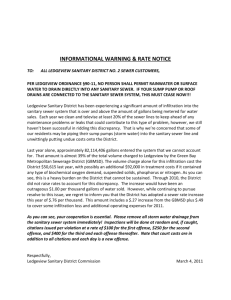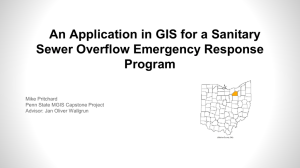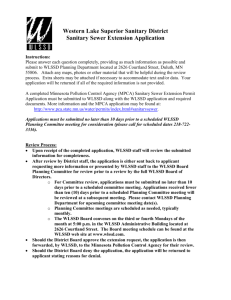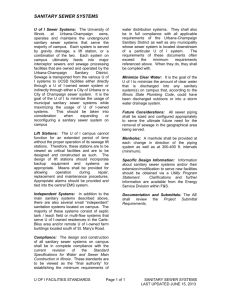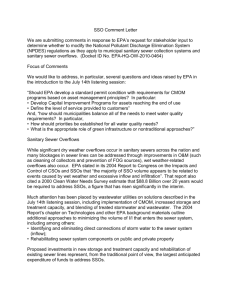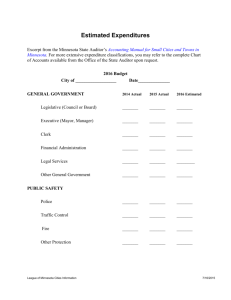Sanitary Sewer Overflow Action Plan
advertisement
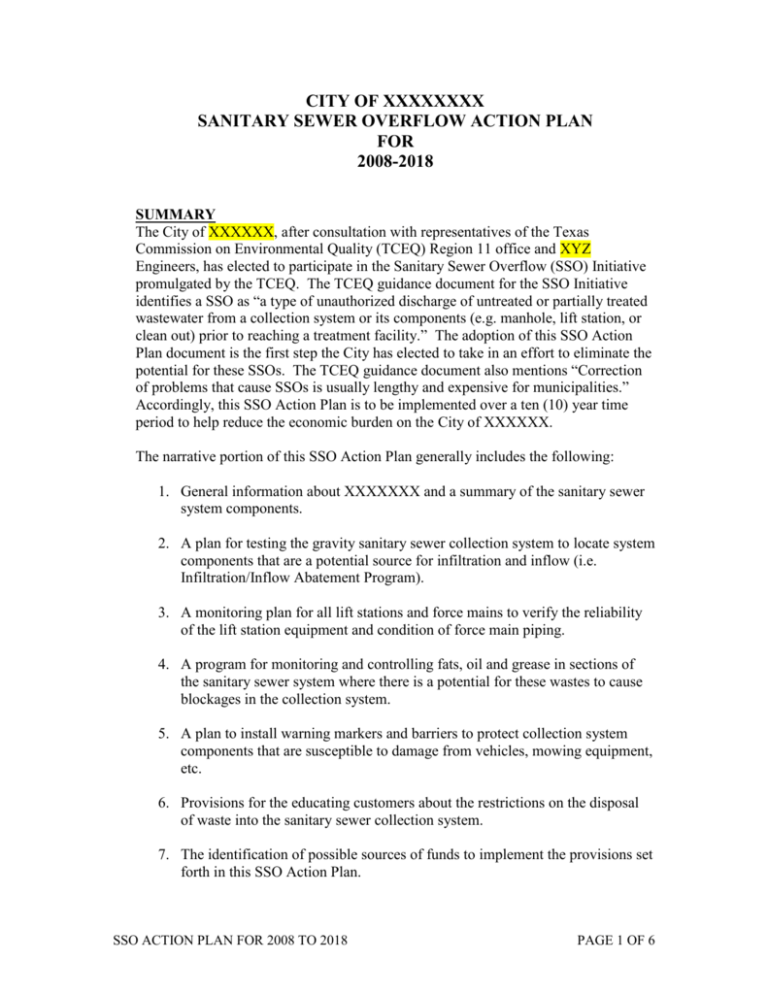
CITY OF XXXXXXXX SANITARY SEWER OVERFLOW ACTION PLAN FOR 2008-2018 SUMMARY The City of XXXXXX, after consultation with representatives of the Texas Commission on Environmental Quality (TCEQ) Region 11 office and XYZ Engineers, has elected to participate in the Sanitary Sewer Overflow (SSO) Initiative promulgated by the TCEQ. The TCEQ guidance document for the SSO Initiative identifies a SSO as “a type of unauthorized discharge of untreated or partially treated wastewater from a collection system or its components (e.g. manhole, lift station, or clean out) prior to reaching a treatment facility.” The adoption of this SSO Action Plan document is the first step the City has elected to take in an effort to eliminate the potential for these SSOs. The TCEQ guidance document also mentions “Correction of problems that cause SSOs is usually lengthy and expensive for municipalities.” Accordingly, this SSO Action Plan is to be implemented over a ten (10) year time period to help reduce the economic burden on the City of XXXXXX. The narrative portion of this SSO Action Plan generally includes the following: 1. General information about XXXXXXX and a summary of the sanitary sewer system components. 2. A plan for testing the gravity sanitary sewer collection system to locate system components that are a potential source for infiltration and inflow (i.e. Infiltration/Inflow Abatement Program). 3. A monitoring plan for all lift stations and force mains to verify the reliability of the lift station equipment and condition of force main piping. 4. A program for monitoring and controlling fats, oil and grease in sections of the sanitary sewer system where there is a potential for these wastes to cause blockages in the collection system. 5. A plan to install warning markers and barriers to protect collection system components that are susceptible to damage from vehicles, mowing equipment, etc. 6. Provisions for the educating customers about the restrictions on the disposal of waste into the sanitary sewer collection system. 7. The identification of possible sources of funds to implement the provisions set forth in this SSO Action Plan. SSO ACTION PLAN FOR 2008 TO 2018 PAGE 1 OF 6 8. Provisions for the documentation of the progress and problems during the implementation of this SSO Action Plan. In addition to the above information, this SSO Action Plan includes the following exhibits: 1. Exhibit A – SSO Action Plan Schedule (2008 to 2018). 2. Exhibit B – Summary of Collection System Components. 3. Exhibit C – Sanitary Sewer System Map With Areas For SSO Action Plan. All of the above exhibits are included at the end of this document. It should be noted that the sanitary sewer system has been divided into four (4) separate areas so the City can implement the SSO Action Plan in stages as shown in Exhibit A. The four (4) SSO Action Plan Areas are delineated on the sanitary sewer system map that is included with this document as Exhibit C. GENERAL INFORMATION AND SYSTEM DATA According to census data, XXXXX had a population of XXXX persons in 2000 and an estimated population of XXXX in July 2006. XXXXXX is geographically located XXXXX. The City provides various utility services to customers including services related to sanitary sewer collection and treatment. In addition to two (2) wastewater treatment plant facilities, the City’s sanitary sewer system includes the following components: 1. 137,989 linear feet (LF) of gravity sanitary sewer main lines that range in size from 4-inches diameter up to 12-inches diameter. The gravity collection lines are composed of the following approximate lengths of pipe material: a. b. c. d. e. 49,378 LF Of PVC Pipe, 78,316 LF Of Clay Pipe, 144 LF Of Concrete Pipe, 714 LF Of Ductile Iron or Cast Iron Pipe, and 9,437 LF Of Unknown Pipe Type. 2. 368 Each Sanitary Sewer Manholes. 3. 17 Each Sanitary Sewer Lift Stations and 19,154 LF of Force Main Piping. All of the above facilities are owned, operated, and maintained by the City of XXXXXXX. SSO ACTION PLAN FOR 2008 TO 2018 PAGE 2 OF 6 TESTING AND INSPECTION OF SANITARY SEWER COLLECTION SYSTEM COMPONENTS (GRAVITY) A significant problem on most all sanitary sewer collection systems is infiltration and inflow. Testing and inspection of systems must be done to identify the sources of infiltration and inflow. As part of this SSO Action Plan, the City of XXXXXXX will implement an Infiltration/Inflow (I/I) Abatement Program that will consist of the following: 1. Manhole Inspection: This effort will include the physical inspection of each manhole to ascertain the general integrity of the manhole and determine whether or not the manhole needs replacement or rehabilitation. Signs indicating surcharge or leakage during wet weather will be recorded as part of the inspection process. Depths and types of influent and effluent lines will also be recorded and used to update the Sanitary Sewer System Map as noted below in Item 3. 2. Smoke Testing: The smoke testing process will be performed to identify sources of wet weather inflow and groundwater infiltration on all gravity type sewer lines. Smoke testing also helps identify if there are any illegal crossconnections between stormwater drainage facilities and the sanitary sewer collection system components. 3. Update Sanitary Sewer System Map: Data gathered during the smoke testing and manhole inspection process will be used to update the sanitary sewer system map. 4. Line Cleaning and TV Inspection: Lines that are charged or have blockages caused by other problems will be cleaned with the appropriate line jetting equipment and inspected with CCTV equipment when necessary. 5. Reports: Reports on the results of manhole inspections, smoke testing of collection lines and smoke testing of service/yard lines will be developed and reviewed to identify the deficiencies that need to be corrected. The I/I Abatement Program will be implemented for each area of the sanitary sewer system that is delineated on the system map in Exhibit C for this Plan. Exhibit A includes the schedule for smoke testing each area that is shown on the system map in Exhibit C. All manholes for each area will be inspected at the same time the system is smoke tested. Finally, it is vital that the Code of Ordinances for the City of XXXXXXXX be updated, if necessary, to require customers to make repairs to their private sewer service lines (i.e. yard lines) if leaks or other deficiencies are discovered on these lines during the smoke testing portion of the I/I Abatement Program. SSO ACTION PLAN FOR 2008 TO 2018 PAGE 3 OF 6 LIFT STATION AND FORCE MAIN MONITORING PLAN Each of the XXXX lift stations that are part of the sanitary sewer system for the City of XXXXXX will be visited by city personnel no less than once per week to verify general operating condition and determine the need for normal maintenance and repairs. Records of observations on each visit will be maintained. In addition, a more thorough annual inspection will be performed to determine the need for major renovations, replacement or repairs for components at each lift station. Hour meters will be also installed for any pumps that don’t have hour meters or replaced for pumps with defective hour meters. It is important to record and monitor the pump run times at each lift station to ascertain if there are any abnormal peak flows that a lift station is not designed to contend with or if I/I problems have developed in the contributing drainage area of a lift station. Another important component to monitor is force mains and most major problems with force mains can be noticed by a simple visual inspection of the route these lines follow. The SSO Action Plan Schedule in Exhibit A provides the information on the activities required for the Lift Station and Force Main Monitoring Plan. MONITORING AND CONTROL PROGRAM FOR FATS, OIL AND GREASE A major cause of blockages in sanitary sewer lines is fats, oil and grease and the line blockages caused by these wastes can easily cause SSOs. As part of this SSO Action Plan, the City will develop a program for monitoring and controlling these wastes. Restaurants and other food preparation establishments (i.e. schools, nursing homes) are customers that commonly generate enough fat, oil and grease waste to cause blockages in lines. The first part of the monitoring and control program will be to establish/update an ordinance that will provide the City of XXXXXXXX with the proper authority to regulate their customers that could potentially discharge fat, oil and grease waste into the sanitary sewer collection system (i.e. a “grease trap ordinance”). Under this ordinance, the City should be able to require customers that generate the fat, oil and grease waste to install, replace and/or maintain the proper grease removal or trapping equipment so as to prevent the entry of this waste into the sanitary sewer collection system. The next part of the program will include the City conducting a survey or review of their customers that should have grease removal or trapping equipment at their facility and then verify whether or not these customers have the proper equipment. To insure that these customers maintain their equipment, the City will also conduct regular inspections of each customer required to have a grease trap and verify that it is functioning properly and does not need to be pumped, replaced or repaired. The frequency for these inspections is listed in the schedule for this SSO Action Plan included in Exhibit A. PROTECTION PROGRAM FOR SYSTEM COMPONENTS A rather simple and inexpensive part of this SSO Action Plan is to develop a protection program for those system components that are susceptible to damage. For example, a warning marker or barrier can be erected for a manhole that is in a location that can be damaged by mowing equipment or other vehicles. While this may seem minor, a manhole with a missing or damaged top can be a major source of I/I if located in a flood prone area and a warning marker or barrier can help prevent SSO ACTION PLAN FOR 2008 TO 2018 PAGE 4 OF 6 damage to these damage prone manholes. Warning markers and barriers also help city personnel find these manholes when they need to verify the condition of the manholes. Manholes or other system components that are susceptible to damage will be marked or protected and then inspected on an annual basis as listed in the SSO Action Plan Schedule in Exhibit A. EDUCATION OF CUSTOMERS An area often overlooked by operators of sanitary sewer systems is the education of their customers. Distributing informative material to customers about the proper method to dispose of various wastes is one way to help prevent SSOs. This type of action can be done through inserts in utility bills that are mailed to customers, postings on a City website, and publishing educational notices in the local newspaper. The SSO Action Plan Schedule in Exhibit A includes several key actions that will be taken to educate customers. FUNDING OPTIONS Funding for the activities associated with this Plan will likely come from more than one source. Revenue generated by customer utility bills will be one source of funding. Tax revenue will be another source of funding. At times, the City may find it prudent to obtain low interest bonds, issue bonds, or issue certificates of obligations to fund the activities of this Action Plan. The opportunity for obtaining monetary grants from various state and federal government agencies will be explored, but are typically difficult to obtain. DOCUMENTATION OF PROGRESS AND PROBLEMS As with most any plan, it will be vital to document the progress and problems during the implementation of this SSO Action Plan. The City of XXXXXX will maintain a log of activities, improvements and problems throughout the entire duration of the SSO Action Plan. The documentation process will be continuous and is intended to help city personnel and regulators determine the progress and effectiveness of this SSO Action Plan. The documentation process will also help city personnel develop any necessary updates or revisions to this SSO Action Plan during the 2008 to 2018 implementation period. INTERIM MITIGATION MEASURES FOR SSOs During the ten (10) year implementation period for this SSO Action Plan, it is possible that SSOs may occur in locations other than the primary area where the current work effort is taking place at that time. For instance, work could be ongoing or scheduled in Area I during 2009 and a SSO event could occur in Area IV where the work effort will not occur until a later date in the SSO Action Plan schedule. In the event that this happens, it will be important for the City to make adjustments and implement interim mitigation measures to correct the cause of an SSO that occurs in an area where the work effort is not currently in progress. A SSO at any location on the sanitary sewer system and the cause of the SSO cannot be disregarded at any time. There must be commitment to mitigate all SSOs that occur throughout the entire duration of the SSO Action Plan as well as after the end of the Plan. SSO ACTION PLAN FOR 2008 TO 2018 PAGE 5 OF 6 LIST OF EXHIBITS EXHIBIT A SANITARY SEWER OVERFLOW (SSO) ACTION PLAN SCHEDULE (2008 TO 2018) EXHIBIT B SUMMARY OF COLLECTION SYSTEM COMPONENTS EXHIBIT C SANITARY SEWER SYSTEM MAP WITH AREAS FOR SSO ACTION PLAN SSO ACTION PLAN FOR 2008 TO 2018 PAGE 6 OF 6
